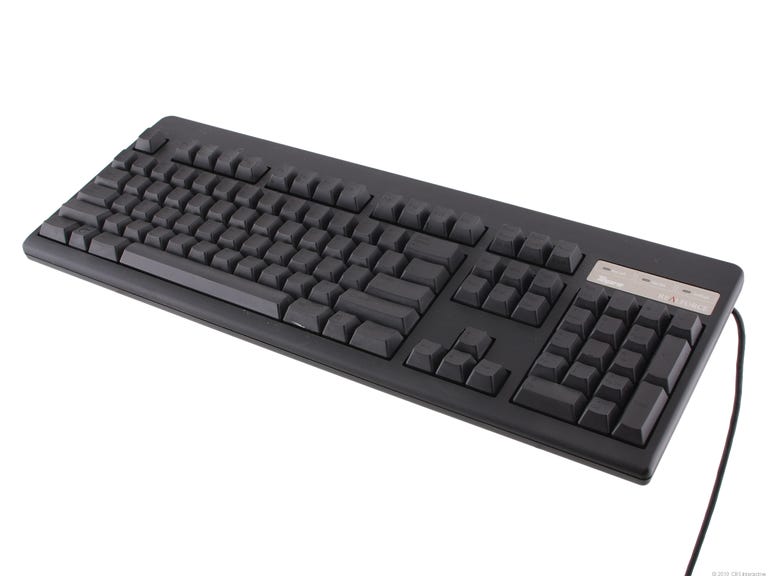 Why You Can Trust CNET
Why You Can Trust CNET Realforce 103UB 55g (black) review: Realforce 103UB 55g (black)
Realforce 103UB 55g (black)
Typing purists maintain that the IBM Model M keyboard will always be the standard to compare modern keyboard designs to, particularly for the satisfying "clack" made by the switches underneath and the fast response from those switches that loyalists claim increases speed and accuracy. The recent popularity of mechanical keyboards has led foreign manufacturers like Topre (formerly Tokyo Press Kogyo) to introduce new versions like the Realforce 103UB 55-gram keyboard. Priced at $245, the 103UB costs substantially more than competitive models like the Das Keyboard or the Rosewill RK-9000, but uses proprietary sensors instead of the standard Cherry key switches to maintain the mechanical typing experience without the clicking that tends to annoy others.
The Good
The Bad
The Bottom Line
Topre also highlights its extra-tough build quality compared with the cheap keyboards you get with store-bought computers, but we still wish for a few more extras given the cost. We recommend the Realforce 103UB to hard-core keyboard jockeys with extra cash and sensitive ears, but others will find the equally responsive, less expensive Rosewill RK-9000 and Das Keyboard more viable options.
The body of the Realforce 103UB feels sturdier than the Das Keyboard or the Rosewill RK-9000. We're not worried about the failure rates of those competing models, but the Topre board may have more appeal if that's a particular concern for you. At a little more than 3 pounds, the Topre's heft ensures that it stays in one place on your desk.
The keyboard uses the classic QWERTY layout with a row of F1 through F12 keys across the top, a numerical keypad on the right, and three LED lights built into the board to indicate Number Lock, Caps Lock, and Scroll Lock. The back of the device features two rubber feet that add even more grip, and two tabs on either side flip up to vary the angle of your wrists in relation to the keys.
The 103UB we tested has 103 keys that weigh 55g each, but Topre also sells a version of the 103UB that uses varying 35- and 45-gram switches to reduce the effort of typing pinky-stroke characters that take more force to actuate and can often lead to fatigue over long typing sessions.
The keycap shapes vary by the rows on the board to accommodate the ideal typing angle for your hands. You can't use generic keycap replacements as a result, but Topre includes a key puller, alternate colors for the W, A, S, and D keys, a red escape key, and additional Caps Lock and Ctrl keys for programmers who want to swap the two.
Each key label is formed using dye-sublimation print methods instead of traditional laser printing, which tends to wear off quickly. The subtle gray-on-gray finish also adds extra texture that lightly grasps your fingers while you type.
Topre designed its 55g electrostatic key switches organically using elements from traditional rubber dome switches, capacitive sensors, and snap-action mechanical keyboards, and the result is a new kind of hybrid switch that requires more force to register but buckles more quickly with a 4-millimeter travel distance per stroke.
Consequently, the keys don't bounce back as quickly as Cherry switches, so you won't hear the irritating clicking noise typically associated with mechanical keyboards, as verified by my cube neighbors in the office. You will, however, notice a big difference in typing comfort if you're used to the traditional scissor-switch laptop keyboard.
The resistance against your fingers comes from a rubber dome underneath the keys to extend the actuation point, so it actually feels less springy than the Cherry switches. Whereas the bounce on Cherry switches almost makes it feel like the switches are actuating for you, the Topre Realforce 103UB can feel clunky at first, so we needed some adjustment time after testing other mechanical keyboards, but after a week of use we were able to type more quickly and with slightly better accuracy.
On the other hand, the Realforce 103UB keyboard offers no extras that we've seen on other mechanical keyboards. You don't get any additional USB ports or media buttons, nor does it have the durable braided USB cord that we preferred on the Rosewill RK-9000. We recognize that the design of most mechanical keyboards focuses on typing rather than media controls, but it's hard to ignore the Topre's price tag when you compare it with a device like the Logitech Wireless Keyboard K350 that integrates an ergonomic design, a wireless Unifying Receiver, a wrist rest, and a collection of customizable media keys for under $100.
At a $100 premium over its mechanical competition, the Topre's build quality and quiet typing don't quite justify the higher price. We like the overall feel of the keyboard, but would prefer to see more for its price.


